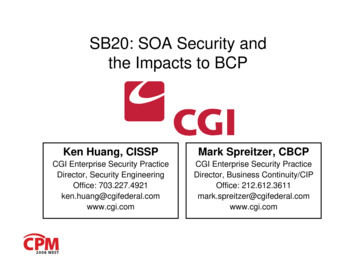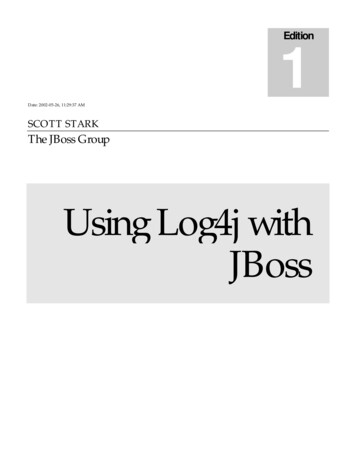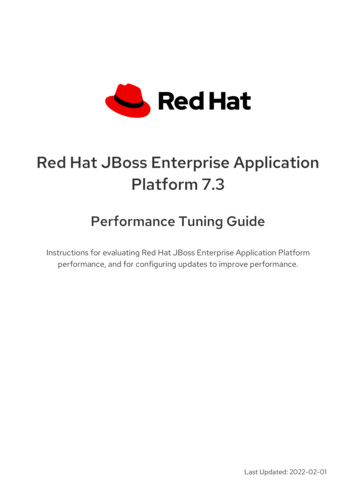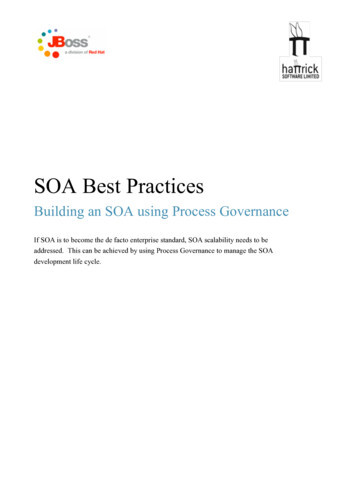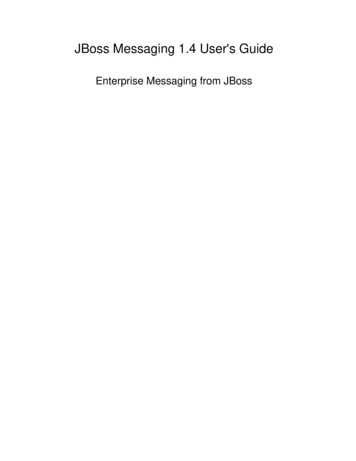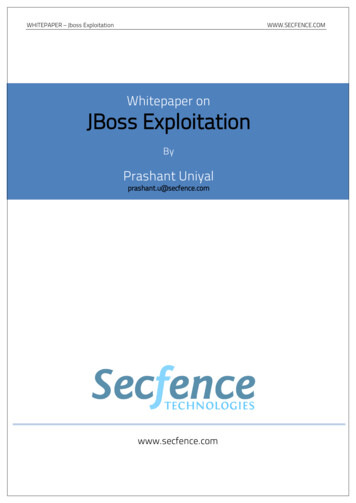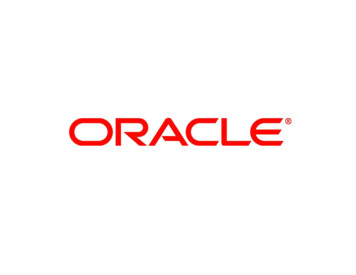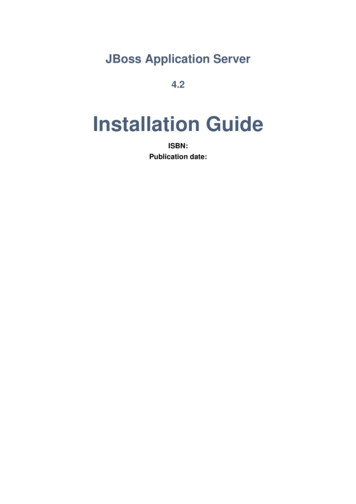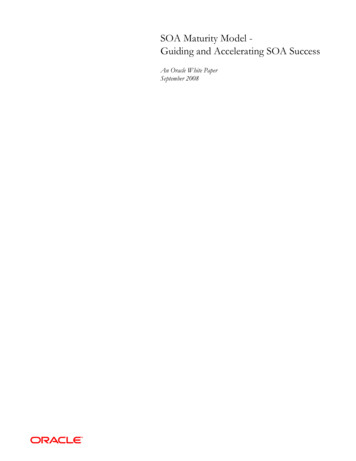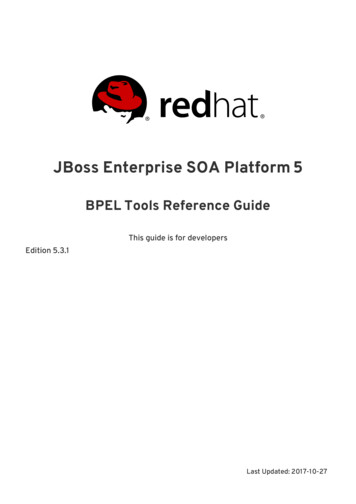
Transcription
JBoss Enterprise SOA Platform 5BPEL Tools Reference GuideThis guide is for developersEdition 5.3.1Last Updated: 2017-10-27
JBoss Enterprise SOA Platform 5 BPEL Tools Reference GuideThis guide is for developersEdition 5.3.1David Le SageRed Hat Engineering Content Servicesdlesage@redhat.com
Legal NoticeCopyright 2013 Red Hat, Inc.This document is licensed by Red Hat under the Creative Commons Attribution-ShareAlike 3.0Unported License. If you distribute this document, or a modified version of it, you must provideattribution to Red Hat, Inc. and provide a link to the original. If the document is modified, all RedHat trademarks must be removed.Red Hat, as the licensor of this document, waives the right to enforce, and agrees not to assert,Section 4d of CC-BY-SA to the fullest extent permitted by applicable law.Red Hat, Red Hat Enterprise Linux, the Shadowman logo, JBoss, OpenShift, Fedora, the Infinitylogo, and RHCE are trademarks of Red Hat, Inc., registered in the United States and othercountries.Linux is the registered trademark of Linus Torvalds in the United States and other countries.Java is a registered trademark of Oracle and/or its affiliates.XFS is a trademark of Silicon Graphics International Corp. or its subsidiaries in the UnitedStates and/or other countries.MySQL is a registered trademark of MySQL AB in the United States, the European Union andother countries.Node.js is an official trademark of Joyent. Red Hat Software Collections is not formally relatedto or endorsed by the official Joyent Node.js open source or commercial project.The OpenStack Word Mark and OpenStack logo are either registered trademarks/service marksor trademarks/service marks of the OpenStack Foundation, in the United States and othercountries and are used with the OpenStack Foundation's permission. We are not affiliated with,endorsed or sponsored by the OpenStack Foundation, or the OpenStack community.All other trademarks are the property of their respective owners.AbstractThis guide teaches developers to use JBDS' BPEL plug-in.
Table of ContentsTable of Contents. . . . . . . . . . . . . . . . . . . . . . . . . . . . . . . . . . . . . . . . . . . . . . . . . . . . . . . . . . . . . . . . . . . . . . . . . . . . . . . . . . . . . . . . . . . . . . . . . . . . . . . . . . . . .2. . . . . . . . . . . .PREFACE.CHAPTER. . . . . . . . . . 1. .PREFACE. . . . . . . . . . . . . . . . . . . . . . . . . . . . . . . . . . . . . . . . . . . . . . . . . . . . . . . . . . . . . . . . . . . . . . . . . . . . . . . . . . . . . . . . . . . . . . . .3. . . . . . . . . . . .1.1. BUSINESS INTEGRATION31.2. WHAT IS A SERVICE-ORIENTED ARCHITECTURE?31.3. KEY POINTS OF A SERVICE-ORIENTED ARCHITECTURE31.4. WHAT IS THE JBOSS ENTERPRISE SOA PLATFORM?41.5. THE SERVICE-ORIENTED ARCHITECTURE PARADIGM41.6. CORE AND COMPONENTS41.7. COMPONENTS OF THE JBOSS ENTERPRISE SOA PLATFORM51.8. JBOSS ENTERPRISE SOA PLATFORM FEATURES51.9. FEATURES OF THE JBOSS ENTERPRISE SOA PLATFORM'S JBOSSESB COMPONENT51.10. TASK MANAGEMENT61.11. INTEGRATION USE CASE61.12. UTILISING THE JBOSS ENTERPRISE SOA PLATFORM IN A BUSINESS ENVIRONMENT7. . . . . . . . . . . 2.CHAPTER. . INTRODUCTION. . . . . . . . . . . . . . . . . . . . . . . . . . . . . . . . . . . . . . . . . . . . . . . . . . . . . . . . . . . . . . . . . . . . . . . . . . . . . . . . . . . . . . . . . . . . . . . .8. . . . . . . . . . . .2.1. INTENDED AUDIENCE82.2. AIM OF THE GUIDE2.3. INSTALLATION88. . . . . . . . . . . 3.CHAPTER. . TASKS. . . . . . . . . . . . . . . . . . . . . . . . . . . . . . . . . . . . . . . . . . . . . . . . . . . . . . . . . . . . . . . . . . . . . . . . . . . . . . . . . . . . . . . . . . . . . . . .9. . . . . . . . . . . .3.1. CREATING A BPEL PROJECT3.2. CREATING A BPEL PROCESS3.3. CREATE A NEW SERVER RUNTIME911143.4. EDITING A BPEL PROCESS FILE3.5. TABS SHOWN IN THE PROPERTIES VIEW15153.6. OBSERVING A BPEL PROCESS3.7. ADDING A SERVICE TO A WSDL FILE16163.8. CREATING A DEPLOY.XML FILE3.9. CREATING JBOSS BPEL SERVER19213.10. CREATING CORRELATION SETS24.CHAPTER. . . . . . . . . . 4. . .REFERENCE. . . . . . . . . . . . . . . . . . . . . . . . . . . . . . . . . . . . . . . . . . . . . . . . . . . . . . . . . . . . . . . . . . . . . . . . . . . . . . . . . . . . . . . . . . . . . 25.4.1. WIZARDS254.2. VIEWS4.3. PROPERTY SECTION TABS4.4. PROCESS PROPERTY SHEET TABS4.5. DETAILS TAB OPTIONS252627284.6. BPEL DESIGNER FEATURES4.7. BPEL DESIGNER CONCEPTS4.8. STRUCTURED ACTIVITIES4.9. FAULT, COMPENSATION, TERMINATION AND EVENT HANDLERS313233364.10. BPEL DEPLOYMENT DESCRIPTOR EDITOR PROPERTIES4.11. DIALOGS4.12. TYPE SELECTION4.13. SELECT WSDL PROPERTY4.14. CREATE WSDL PROPERTY36373839394.15. CREATE WSDL PROPERTY ALIAS4.16. CHEAT SHEETS4.17. CONTEXT MENU404041. . . . . . . . . . . . A.APPENDIX. . .REVISION. . . . . . . . . . HISTORY. . . . . . . . . . . . . . . . . . . . . . . . . . . . . . . . . . . . . . . . . . . . . . . . . . . . . . . . . . . . . . . . . . . . . . . . . . . . . . . . . . 42.1
BPEL Tools Reference GuidePREFACE2
CHAPTER 1. PREFACECHAPTER 1. PREFACE1.1. BUSINESS INTEGRATIONIn order to provide a dynamic and competitive business infrastructure, it is crucial to have a serviceoriented architecture in place that enables your disparate applications and data sources tocommunicate with each other with minimum overhead.The JBoss Enterprise SOA Platform is a framework capable of orchestrating business services withoutthe need to constantly reprogram them to fit changes in business processes. By using its businessrules and message transformation and routing capabilities, JBoss Enterprise SOA Platform enablesyou to manipulate business data from multiple sources.Report a bug1.2. WHAT IS A SERVICE-ORIENTED ARCHITECTURE?IntroductionA Service Oriented Architecture (SOA) is not a single program or technology. Think of it, rather, as asoftware design paradigm.As you may already know, a hardware bus is a physical connector that ties together multiple systemsand subsystems. If you use one, instead of having a large number of point-to-point connectors betweenpairs of systems, you can simply connect each system to the central bus. An enterprise service bus(ESB) does exactly the same thing in software.The ESB sits in the architectural layer above a messaging system. This messaging system facilitatesasynchronous communications between services through the ESB. In fact, when you are using an ESB,everything is, conceptually, either a service (which, in this context, is your application software) or amessage being sent between services. The services are listed as connection addresses (known as endpoints references.)It is important to note that, in this context, a "service" is not necessarily always a web service. Othertypes of applications, using such transports as File Transfer Protocol and the Java Message Service,can also be "services."NOTEAt this point, you may be wondering if an enterprise service bus is the same thing as aservice-oriented architecture. The answer is, "Not exactly." An ESB does not form aservice-oriented architecture of itself. Rather, it provides many of the tools than can beused to build one. In particular, it facilitates the loose-coupling and asynchronous messagepassing needed by a SOA. Always think of a SOA as being more than just software: it is aseries of principles, patterns and best practices.Report a bug1.3. KEY POINTS OF A SERVICE-ORIENTED ARCHITECTUREThese are the key components of a service-oriented architecture:3
BPEL Tools Reference Guide1. the messages being exchanged2. the agents that act as service requesters and providers3. the shared transport mechanisms that allow the messages to flow back and forth.Report a bug1.4. WHAT IS THE JBOSS ENTERPRISE SOA PLATFORM?The JBoss Enterprise SOA Platform is a framework for developing enterprise application integration(EAI) and service-oriented architecture (SOA) solutions. It is made up of an enterprise service bus(JBoss ESB) and some business process automation infrastructure. It allows you to build, deploy,integrate and orchestrate business services.Report a bug1.5. THE SERVICE-ORIENTED ARCHITECTURE PARADIGMThe service-oriented architecture (SOA) consists of three roles: requester, provider, and broker.Service ProviderA service provider allows access to services, creates a description of a service and publishes it tothe service broker.Service RequesterA service requester is responsible for discovering a service by searching through the servicedescriptions given by the service broker. A requester is also responsible for binding to servicesprovided by the service provider.Service BrokerA service broker hosts a registry of service descriptions. It is responsible for linking a requester to aservice provider.Report a bug1.6. CORE AND COMPONENTSThe JBoss Enterprise SOA Platform provides a comprehensive server for your data integration needs.On a basic level, it is capable of updating business rules and routing messages through an EnterpriseService Bus.The heart of the JBoss Enterprise SOA Platform is the Enterprise Service Bus. JBoss (ESB) creates anenvironment for sending and receiving messages. It is able to apply “actions” to messages to transformthem and route them between services.There are a number of components that make up the JBoss Enterprise SOA Platform. Along with theESB, there is a registry (jUDDI), transformation engine (Smooks), message queue (HornetQ) and BPELengine (Riftsaw).4
CHAPTER 1. PREFACEReport a bug1.7. COMPONENTS OF THE JBOSS ENTERPRISE SOA PLATFORMA full Java EE-compliant application server (the JBoss Enterprise Application Platform)an enterprise service bus (JBoss ESB)a business process management system (jBPM)a business rules engine (JBoss Rules)support for the optional JBoss Enterprise Data Services (EDS) product.Report a bug1.8. JBOSS ENTERPRISE SOA PLATFORM FEATURESThe JBoss Enterprise Service Bus (ESB)The ESB sends messages between services and transforms them so that they can be processed bydifferent types of systems.Business Process Execution Language (BPEL)You can use web services to orchestrate business rules using this language. It is included with SOAfor the simple execution of business process instructions.Java Universal Description, Discovery and Integration (jUDDI)This is the default service registry in SOA. It is where all the information pertaining to services onthe ESB are stored.SmooksThis transformation engine can be used in conjunction with SOA to process messages. It can alsobe used to split messages and send them to the correct destination.JBoss RulesThis is the rules engine that is packaged with SOA. It can infer data from the messages it receives todetermine which actions need to be performed.Report a bug1.9. FEATURES OF THE JBOSS ENTERPRISE SOA PLATFORM'SJBOSSESB COMPONENTThe JBoss Enterprise SOA Platform's JBossESB component supports:Multiple transports and protocolsA listener-action model (so that you can loosely-couple services together)5
BPEL Tools Reference GuideContent-based routing (through the JBoss Rules engine, XPath, Regex and Smooks)Integration with the JBoss Business Process Manager (jBPM) in order to provide serviceorchestration functionalityIntegration with JBoss Rules in order to provide business rules development functionality.Integration with a BPEL engine.Furthermore, the ESB allows you to integrate legacy systems in new deployments and have themcommunicate either synchronously or asynchronously.In addition, the enterprise service bus provides an infrastructure and set of tools that can:Be configured to work with a wide variety of transport mechanisms (such as e-mail and JMS),Be used as a general-purpose object repository,Allow you to implement pluggable data transformation mechanisms,Support logging of interactions.IMPORTANTThere are two trees within the source code: org.jboss.internal.soa.esb andorg.jboss.soa.esb. Use the contents of the org.jboss.internal.soa.esbpackage sparingly because they are subject to change without notice. By contrast,everything within the org.jboss.soa.esb package is covered by Red Hat'sdeprecation policy.Report a bug1.10. TASK MANAGEMENTJBoss SOA simplifies tasks by designating tasks to be performed universally across all systems itaffects. This means that the user does not have to configure the task to run separately on eachterminal. Users can connect systems easily by using web services.Businesses can save time and money by using JBoss SOA to delegate their transactions once acrosstheir networks instead of multiple times for each machine. This also decreases the chance of errorsocurring.Report a bug1.11. INTEGRATION USE CASEAcme Equity is a large financial service. The company possesses many databases and systems. Someare older, COBOL-based legacy systems and some are databases obtained through the acquisition ofsmaller companies in recent years. It is challenging and expensive to integrate these databases asbusiness rules frequently change. The company wants to develop a new series of client-facing ecommerce websites, but these may not synchronise well with the existing systems as they currentlystand.6
CHAPTER 1. PREFACEThe company wants an inexpensive solution but one that will adhere to the strict regulations andsecurity requirements of the financial sector. What the company does not want to do is to have to writeand maintain “glue code” to connect their legacy databases and systems.The JBoss Enterprise SOA Platform was selected as a middleware layer to integrate these legacysystems with the new customer websites. It provides a bridge between front-end and back-endsystems. Business rules implemented with the JBoss Enterprise SOA Platform can be updated quicklyand easily.As a result, older systems can now synchronise with newer ones due to the unifying methods of SOA.There are no bottlenecks, even with tens of thousands of transactions per month. Various integrationtypes, such as XML, JMS and FTP, are used to move data between systems. Any one of a number ofenterprise-standard messaging systems can be plugged into JBoss Enterprise SOA Platform providingfurther flexibility.An additional benefit is that the system can now be scaled upwards easily as more servers anddatabases are added to the existing infrastructure.Report a bug1.12. UTILISING THE JBOSS ENTERPRISE SOA PLATFORM IN ABUSINESS ENVIRONMENTCost reduction can be achieved due to the implementation of services that can quickly communicatewith each other with less chance of error messages occurring. Through enhanced productivity andsourcing options, ongoing costs can be reduced.Information and business processes can be shared faster because of the increased connectivity. This isenhanced by web services, which can be used to connect clients easily.Legacy systems can be used in conjunction with the web services to allow different systems to "speak"the same language. This reduces the amount of upgrades and custom code required to make systemssynchronise.Report a bug7
BPEL Tools Reference GuideCHAPTER 2. INTRODUCTION2.1. INTENDED AUDIENCEThis book is aimed at developers who wish to learn how to utilize the tools in JBoss BPEL. It explainshow to create new projects, debug projects and how to use editors.Report a bug2.2. AIM OF THE GUIDEThis guide aims to give users an overview of how to use BPEL with projects. Users will be given steps tofollow to create projects and edit those projects. They will also learn about different types of editorsand how to deal with error messages.Report a bug2.3. INSTALLATIONProcedure 2.1. Task1. Click Help - Install New Software. - Add. and insert name and location (forexample, a-tooling/). Then click OK.2. Choose BPEL Editor, then click Next and Next.3. Accept the licence agreement.4. Click Finish and restart your JBDS. (It isn't neccessary to restart computer.)5. The JBoss BPEL Editor will be availible to you after restart.Report a bug8
CHAPTER 3. TASKSCHAPTER 3. TASKS3.1. CREATING A BPEL PROJECT1. First, select File New Project. BPEL 2.0 BPEL Project or Legacy BPEL Projectfrom the menu bar. Then click the Next button.Figure 3.1. Diagram 12. Enter a project name in the Project Name field.9
BPEL Tools Reference GuideFigure 3.2. Diagram 23. Click the Finish button. The following screen will appear.10
CHAPTER 3. TASKSFigure 3.3. Diagram 34. You have now created a new project.Report a bug3.2. CREATING A BPEL PROCESS1. First, select File New Others. BPEL 2.0 BPEL Process File and click Next.11
BPEL Tools Reference GuideFigure 3.4. Diagram 12. From here you can choose to create a BPEL process from a template or a service description.The former is recommended.3. Enter the following information:Table 3.1. Fields and Values12FieldValueBPEL Process NameEnter a process name. For example, HelloWorld.NamespaceEnter or select a namespace for the BPEL process.TemplateSelect the appropriate template for the BPEL process. When youselect the template, you will see information about it. SelectSynchronous BPEL Process.
CHAPTER 3. TASKSFigure 3.5. Diagram 24. Click Next. On this page, you can customize your WSDL service details using a template. Enterthe following information:Table 3.2. Fields and ValuesFieldValueService NameA WSDL service name for the BPEL process. The default name isHelloWorld.Port NameA WSDL port name for the BPEL process. The default name isHelloWorldPort.Service AddressAn address of the WSDL service for the BPEL process. The defaultvalue is http://localhost:8080/HelloWorld.Binding ProtocolThe binding protocol that you use in the WSDL. You can chooseSOAP or HTTP. The default value is SOAP.13
BPEL Tools Reference GuideFigure 3.6. Diagram 35. Click the Next button. On the this page, you can select a folder for the process file from theprojects in your workspace. If a folder is not selected, the default folderHelloWorld/bpelContent will be used.6. Click the Finish button. The process is complete.NOTEAll of the files used in your BPEL project must be under the bpelContentfolder of a BPEL project.Report a bug3.3. CREATE A NEW SERVER RUNTIMEProcedure 3.1. Task1. Go to the New Server wizard.2. Click on Add.3. Fill in the name if you wish to do so (this step is optional because the name is preset.14
CHAPTER 3. TASKS4. Click on Browse and select the home directory.5. Select one of the available configurations (the configuration you choose must have the BPELengine available).6. Click on Finish.Report a bug3.4. EDITING A BPEL PROCESS FILE1. Open the Properties view and Palette view by right-clicking the BPEL editor andselecting the Show in Properties or Show Palette in Palette view options.Figure 3.7. Diagram 12. In the Palette view, drag and drop your chosen BPEL element into the BPEL editor.3. Switch to the Properties view to see information on the BPEL process.4. The contents of the Properties view is automatically updated as elements are selected inthe BPEL editor.Report a bug3.5. TABS SHOWN IN THE PROPERTIES VIEWTable 3.3. Tabs Shown in the Properties View15
BPEL Tools Reference GuideTabDescriptionDescriptionDisplays information about the element such asname, size, etc.DetailsShows detailed and important information about theelement. Most of the properties of an element are setin this section.Join BehaviorShows the Join Failure property of the element.DocumentationShows the documentation sub-element of anelement.ImportsAllows you to choose which documents will beimported into the BPEL process definition.NamespacesLets you edit the defined namespaces in the BPELprocess document.Report a bug3.6. OBSERVING A BPEL PROCESS1. Change the Empty element between elements receiveInput and replyOutput to Assign.2. Add an Assign element between the receiveInput element and replyOutput element.3. Click the Assign element in the BPEL editor to see the properties information in the Propertiesview.4. Set its name in the Description tab as assignHelloMesg.5. In the Details section of Properties view, click the New button to add a copy sub-element tothe element. Assign "Variable to Variable" (input:string to result:string). An " initializer" popupdialog will appear. Click on the Yes button.6. Navigate down to the desired component and click it. The icon to the left of the componentname indicates its type: a blue dot is the BPEL variable, an envelope is a message, an "e" is anXML element. Click the New button once more and select Expression to Variable (assignconcat( input.payload/tns:input, ' World')) to result:string.Report a bug3.7. ADDING A SERVICE TO A WSDL FILEThe HelloWorldArtifacts.wsdl file is added to a service when you create a BPEL process file. Adefault service is already defined in this WSDL file. However, if you want to add your own service,follow the steps below:16
CHAPTER 3. TASKS1. Open the file HelloWorldArtifacts.wsdl in the HelloWorld project.2. Right-click the WSDL editor and select the Add Service option. A new service should appearin the editor. Name it HelloWorldProcessService. It has the Port named NewPort. Selectit, right-click on it and rename it to HelloWorldProcessPort in the Properties view.Figure 3.8. Diagram 13. Right-click in the whitespace of the WSDL editor and select the Add Binding option. A newBinding component will appear in the editor. Name it HelloWorldSOAPBinding. Select it,and in the General tab of the Properties view and select HelloWorld as a port type in thePortType field.4. Click on the Generate Binding Content. button to open the Binding Wizard.5. In the wizard, select SOAP as the Protocol. Click the Finish button to close the wizard.17
BPEL Tools Reference GuideFigure 3.9. Diagram 26. Click the HelloWorldProcessPort property in the General section of the Propertiesview.7. Select HelloWorldSOAPBinding in the Binding combobox.8. Enter dl in the Address field.Figure 3.10. Diagram 318
CHAPTER 3. TASKSReport a bug3.8. CREATING A DEPLOY.XML FILE1. To create a new deploy.xml file for deploying BPEL projects, select File New Other. BPEL 2.0 BPEL Deployment Descriptor . Click the Next button.Figure 3.11. Diagram 12. On this page of the wizard, enter the BPEL Project. Do so by clicking the Browse. button toselect the BPEL project in your workspace that you want to deploy to the runtime.3. Select the bpelContent folder in your new BPEL project for the BPEL Project field. Do notchange the default file name which is deploy.xml.4. Click on the Finish button to close the wizard and a new deploy.xml file will be created.19
BPEL Tools Reference GuideFigure 3.12. Diagram 25. Finally, double-click the deploy.xml file to open it in ODE Descriptor DeploymentEditor. In the Inbound Interfaces section, click the Associated Port column andselect HelloWorldProcessPort in the combobox.The Related Service and BindingUsed columns should be automatically filled in. Save the changes to the deploy.xml file.20
CHAPTER 3. TASKSFigure 3.13. Diagram 3Report a bug3.9. CREATING JBOSS BPEL SERVER1. Open the Servers view by selecting Windows Show View Other. Server Servers.2. Right-click the Servers view and select New Server to open the New Server wizard.21
BPEL Tools Reference GuideFigure 3.14. Diagram 13. Select JBoss EAP 5.x as a server type.4. Click the Next button. On this page, input your JBoss EAP location. Then click Next.22
CHAPTER 3. TASKSFigure 3.15. Diagram 25. Select HelloWorld, then click the Add button to add the project to the server. Finally, clickthe Finish button.6. Start the server by right-clicking on the server and selecting the Start item.Figure 3.16. Diagram 37. Enter the link http://localhost:8080/bpel-console/app.html in your web browser to access thedeployed processes.Report a bug23
BPEL Tools Reference Guide3.10. CREATING CORRELATION SETS1. To create a correlation for a messaging activity, go to the dashboard tab Correlation Setsand click the plus button. Set a name for the set when prompted.2. In Properties view, click the Details tab and then click the Add. button. This willdisplay the Select a Property dialog.3. Enter a name for the new WSDL property and its type. (Either an XSD simple type or an XMLSchema element.)4. Click the Browse button to select a type. This will display the Type Selection dialog.5. Click New in the Aliases section to create a new WSDL property alias.6. Select either the Message Type, XSD Simple Type or XML scheme Element radio buttonand click Browse to select its type. Click OK.7. A correlation can be assigned to a messaging activity (for example, Invoke, Receive, Reply).Select the activity, click Add on the Correlation property tab and choose the appropriatecorrelation set.Report a bug24
CHAPTER 4. REFERENCECHAPTER 4. REFERENCE4.1. WIZARDSTable 4.1. WizardsWizard nameDescriptionNew BPEL Project wizardCreates a faceted project which can be deployed tothe JBoss Riftsaw runtime engine. It is available byselecting File New Other BPEL 2.0 BPELProject. The bpelContent folder contains all thefiles necessary for your project.New BPEL Process File WizardCreates a BPEL process based on one of severaltemplates defined by the wizard. The wizard assumesthe new BPEL process is to be created in the currentproject of the Project Explorer orNavigator view. If a BPEL process of the samename already exists within the project, a warningmessage will be displayed before any action isperformed.New BPEL Deployment DescriptorUse this wizard to create a DeploymentDescriptor file. This file is a manifest for the webservice and is required if the BPEL process is to bedeployed to a runtime engine. The BPEL DeploymentDescriptor Editor will open once this wizardcompletes.IMPORTANTBPEL artifacts must be contained somewhere within the bpelContent folder hierarchyif you intend to deploy the process. Complex projects may be organized into a folderhierarchy, but these folders must be contained within bpelContent.The Deployment Descriptor file must be contained within the bpelContent folderand at the root of any folder hierarchy.Report a bug4.2. VIEWSTable 4.2. ViewsViewDescription25
BPEL Tools Reference GuideViewDescriptionOutlineThe Outline view provides a structural layout ofthe BPEL process. You can view the process aseither a hierarchical tree-structured outline or as athumbnail view by pressing the associated button.PaletteThe primary editing, creation and viewing tools ofthe BPEL Designer are accessed from the Palette.The Palette can be docked either at the right orleft edge of the BPEL Designer main window, or itcan be detached and displayed in its own view.The Selection Tool is used to selectindividual activities in the editors drawingcanvas. Multiple activities can be selectedby holding the CTRL or SHIFT keys incombination with left mouse click. TheMarquee Tool allows selection ofgroups of activities by dragging a selectionrectangle around them.BPEL activities are created by draggingicons from the labeled Actions,Controls and Faults palette sections(or drawers), onto the editor’s drawingcanvas. These sections can be collapsedand expanded by clicking on individualpalette section titles. They can also bepinned to prevent them from collapsing ifanother section is expanded.The tools at the bottom of the Paletteare used to expand or shrink the drawingcanvas.DashboardReport a bug4.3. PROPERTY SECTION TABSTable 4.3. Property Sections26This panel is embedded in the BPEL Designer canvasand provides a quick overview of the BPEL elementsthat are defined for the currently selected activity orBPEL process. The process name appears at the topof the Dashboard. The main Dashboard area lists allof the Partner Links ,Variables,Correlation Sets and MessageExchanges currently defined for the process. Thegreen plus symbol and grey x symbol allow you toadd and delete each of these elements. In-lineediting of all element names works by selecting thename and then clicking again to enable the editor.
CHAPTER 4. REFERENCENameDescriptionDescription tabThe Description tab contains the activity name.Names must follow XML element namingconventions, limiting characters to letters, numbersand certain special characters only (spaces are notpermitted).Join Behavior tabJoin conditions are evaluated by the target activitiesof links. With the drop-down Expressionlanguage menu, enter an XPath expression thatdefines the condition of the join. The SuppressJoin Failure behavior defined by the process ora containing scope can be overridden with the radiobuttons at the bottom.Correlation tabThe Correlation tab lists all correlations thatare used by the currently selected Receive,Reply or Invoke activity. Correlations can beadded to or removed from the activity through thistab.Namespaces tabNamespaces are URIs (Uniform Resource Identifiers)that uniquely identify a set of resources on theInternet. Shorthand aliases called prefixes aretypically used in XML files to make them morereadable. The Namespaces tab lists all of thenamespace URIs and their prefixes in scope for thecurrently selected activity. Whenever you create areference to an external property (an elementdefined in an XSD) whose namespace has not yetbeen assigned a prefix, the BPEL Designer willprompt you to create a prefix. This can also be donethrough the Namespace tab of the Propertiessheet for the property by clicking the AssignPrefix button.Message Exchange tabMessage exchanges are used to associate a Replyactivity with an inbound message activity and can beeither a Receive, OnMessage or OnEvent. These aredescriptive names given to a request-responseconversation between two parties and must conformto XML element naming conventions.Report a bug4.4. PROCESS PROPERTY SHEET TABSTable 4.4. Process Property Sheet Tabs27
BPEL Tools Reference GuideNameDescriptionDescription tabThe Description tab
The JBoss Enterprise SOA Platform is a framework for developing enterprise application integration (EAI) and service-oriented architecture (SOA) solutions. It is made up of an enterprise service bus (JBoss ESB) and some business process automation infrastructure. It allows you to build, deploy, integrate and orchestrate business services .
